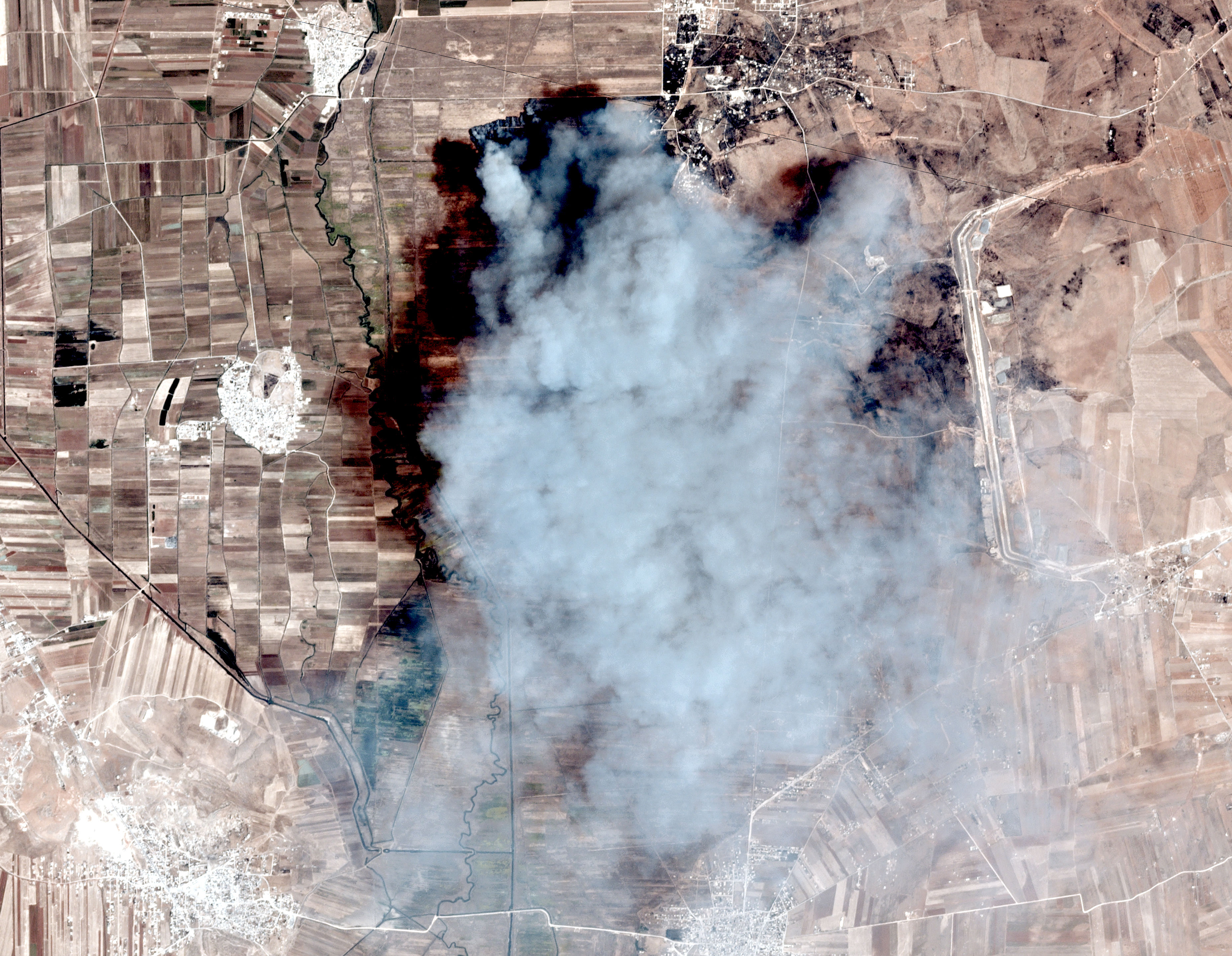Fires near active front lines in Syria – some of them caused by warfare – are ruining large areas of cropland, putting the food insecurity and livelihoods of millions of civilians at increasing risk, the UN has warned.
Some 40,000 hectares of land (400 square kilometres) have burned in live conflict areas on the edges of Syria’s rebel-held northwest since 10 May, according to new satellite analysis conducted by Human Rights Watch and shared with The New Humanitarian.
Syrian government forces and their Russian allies are two months into an offensive on rebels in northwestern Idlib province and surrounding areas. Some 2.5 million people are estimated to live in the region, although exact population statistics are not available, especially given that 300,000 people have been forced to flee the ongoing violence.
The cause of all the fires is not clear. While some appear to have been intentional, others are simply accidental. Some may be a byproduct of war – the result of bombs not intended for crops, for example. Many have been accelerated by unusually hot and dry weather patterns.
Idlib is an important agricultural centre for Syria, and the cost for those people who rely on the crops, either as a source of food or income, is apparent.
“With the harvest season approaching, this will have a huge impact on this year’s crop yield in northwest Syria,” said Nanki Chawla, Syria country coordinator for REACH, an organisation that compiles humanitarian data. “A significant loss of crops is expected to translate to further food insecurity, not only in the short term but also in the months to come.”
Chawla explained that food prices in northwest Syria are already at the highest they have been in 12 months, with wheat prices immediately spiking following the recent fires.
“In an area that is highly dependent on crop production for livelihoods, the humanitarian implications are likely to be immense, with even more of the population becoming reliant on food aid in the months to come,” she added.
Hedinn Halldorsson, a spokesperson for OCHA, the UN’s emergency aid coordination body, said that “interrupted agricultural cycles and harvests, and attacks and destruction of crops and farmland” in northwest Syria are of “grave concern”, adding that they may threaten the food security and livelihoods of “millions of people”.
Natural wildfires are also reported in several other regions of the country where there is little or no active fighting, including in wheat and barley fields in fertile Hassakeh province.
Mixed causes
Activists, including the Syrian civil defence group known as the White Helmets, have accused the government of President Bashar al-Assad of deliberately targeting opposition farmland.
Imagery released by satellite operator Maxar already showed high-resolution pictures of damage – as of 26 May – to fields around northwestern frontline towns and villages, including flashpoint Kafr Nabudah.
← Slide →
Human Rights Watch has also compiled evidence of the use of incendiary and cluster weapons, including on agricultural land, on several occasions in late May.
The latest HRW analysis suggests at least some of the fires were caused by fighting in the area, since they roughly correspond to known areas of recent conflict – although it is not clear if they were accidental, set deliberately, or simply the byproduct of the war.
Josh Lyons, HRW’s director of geospatial analysis, said the watchdog is investigating allegations of the purposeful destruction of farmland and the potentially unlawful use of incendiary weapons. It had not reached any conclusions yet, he said.
A 31 May UN report said that “farms [in northwest Syria] are damaged by shelling and airstrikes, leading to the destruction of crops through burning, including fruit and nut trees.” While it did not attribute blame, only Syrian government and Russian forces have aircraft active in the area.
Climate may also be an important factor in setting crops ablaze, and certainly in the damage they eventually cause.
The weather in late May was unusually hot and dry in Syria and the wider Middle East this year, making it difficult to determine the original cause of many of the fires. High temperatures and dry vegetation make fires easy to start, quick to spread, and hard to suppress.
“The average surface temperature has been higher across the region compared to the 1981-2010 average,” said Mark Parrington, senior scientist at the Copernicus Atmosphere Monitoring Service, or CAMS – housed at the European Centre for Medium-Range Weather Forecasts.
Satellite readings of the total energy output of fires in Syria between 10 May and 5 June also “have been unusually high” compared to the same period in previous years, Parrington added.
On 23 May, the Syrian Directorate of Meteorology warned of heightened fire risk thanks to high temperatures, low humidity and increased vegetation cover.
Firefighters have been pictured at work in social media and news reports in both rebel- and government-held territory, and Syrian state media has blamed rebel shelling and an electric fault for causing some of the fires.
More unknowns in Iraq
In neighbouring Iraq, some 100,000 hectares (1,000 square kilometres) of land has burned since May, according to research published this week by the open-source intelligence website Bellingcat.
Wim Zwijnenburg of the NGO PAX, who conducted the analysis, concluded that some fires had been set by so-called Islamic State – the report says IS uses arson to “displace farmers and extort money and as a scorched-earth tactic”.
But like in Syria, the overall causes are mixed. Matching up “burn scars” in satellite imagery to locations of IS activity shows that large swathes of burned land are likely due to other causes, including bombs, counter-IS airstrikes and, often, “just plain accidents”, Zwijnenburg adds.
While the Iraq fires appear to have hit a wider area than in Syria, the humanitarian impacts have been less widely examined.
bp/as/ag




